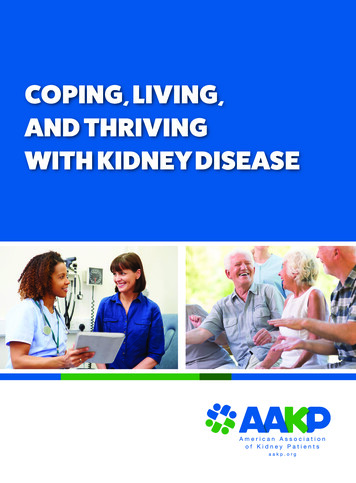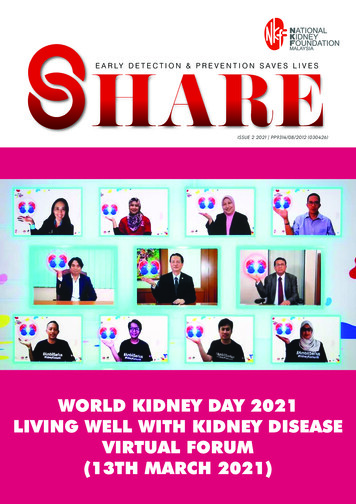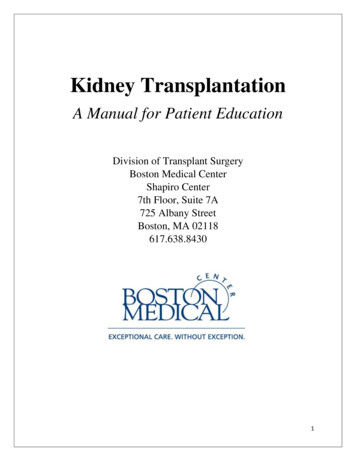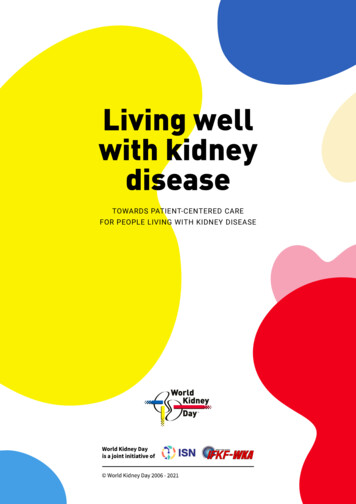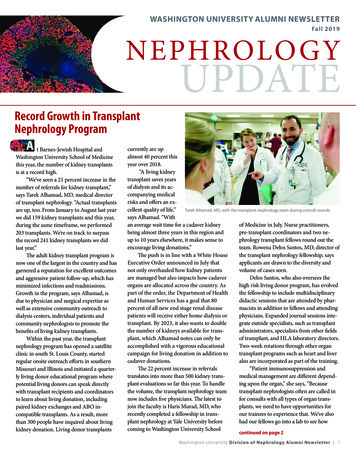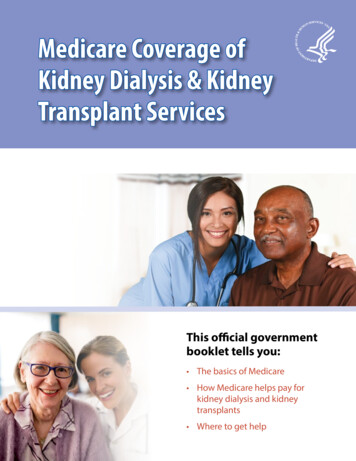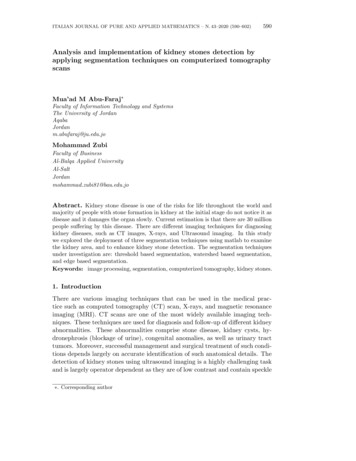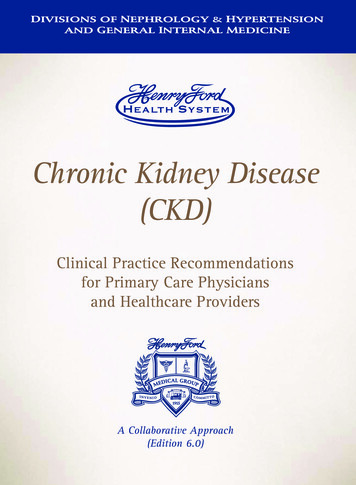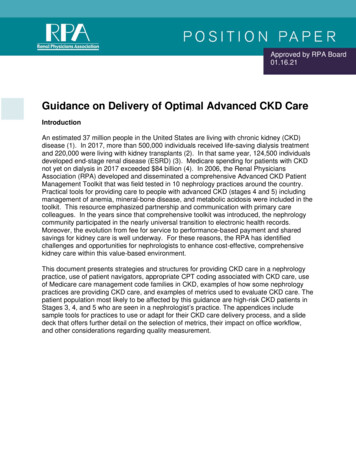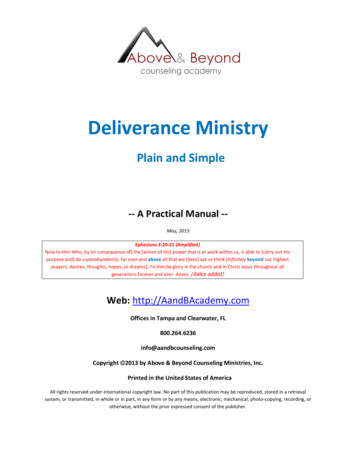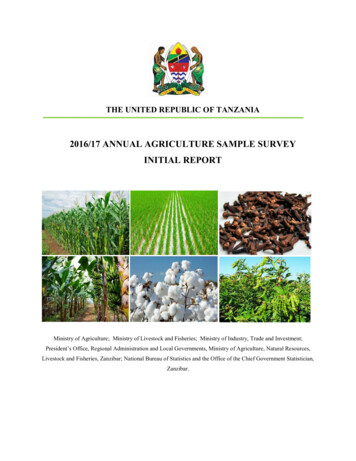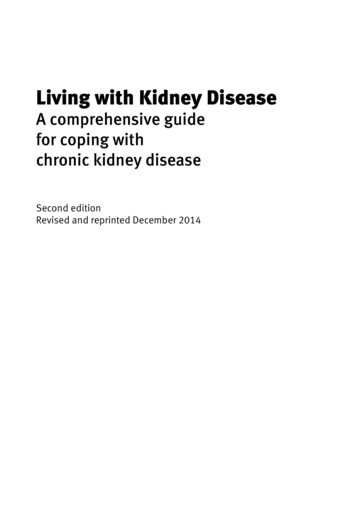
Transcription
Living with Kidney DiseaseA comprehensive guidefor coping withchronic kidney diseaseSecond editionRevised and reprinted December 2014
Citation: Ministry of Health and Kidney HealthNew Zealand. 2014. Living with Kidney Disease:A comprehensive guide for coping withchronic kidney disease. Second edition.Wellington: Ministry of Health.Published in December 2014 by the Ministry of HealthPO Box 5013, Wellington 6145, New ZealandISBN 978-0-478-44466-7 (print)ISBN 978-0-478-44467-4 (online)HP 6098This document is available at:www.health.govt.nzwww.kidneys.co.nz
ContentsAcknowledgementsviiiA note on kidney wordsviiiIntroduction1Chapter 1: Chronic kidney disease in New Zealand2Chapter 2: Your kidneys3What your kidneys do and how do they work3When your kidneys don’t work properly3How do I know if I have kidney disease?4Measuring how your kidneys work – the eGFR4Chronic kidney disease doesn’t always lead to end-stagekidney disease5Types of kidney disease6Acute kidney injury6Chronic kidney disease6End-stage kidney disease7Prevention of kidney disease7Chapter 3: Chronic kidney diseaseSigns and symptoms99Diagnosis10Blood tests10Urea and obin11Living with Kidney Disease: A comprehensive guide for coping with chronic kidney diseaseiii
Diseases that cause the kidneys to fail12Diabetes12High blood pressure12Glomerulonephritis or nephritis13Polycystic kidney disease13Reflux nephropathy14Vascular conditions14Chapter 4: Treatment options15What can I do to help myself?15Treatment choices16Delaying progression through diet17Medications18General18Blood pressure drugs or anti-hypertensives19Erythropoietin19Iron replacement therapy20Phosphate binders20Vitamins and minerals20Cholesterol-lowering drugs21Diuretics21Antibiotics21Treatments for itching21Alternative therapies22Dialysisiv22Haemodialysis23Peritoneal dialysis25Access for dialysis26Choosing a type of dialysis29Living with Kidney Disease: A comprehensive guide for coping with chronic kidney disease
Difference between the two forms of dialysis29Peritoneal dialysis29Haemodialysis30Kidney transplantation30Types of transplant and donors30Who can have a kidney transplant?32Live donor transplants32Advantages and disadvantages33The transplant waiting list34How does the transplant waiting list work?35The transplant operation36After the transplant37Anti-rejection medications38Caring for yourself after the transplant39Choosing not to start dialysis (conservative treatment)41What is conservative treatment?41Why might I decide not to have dialysis treatment?42What does conservative treatment involve?42What if I can’t decide?43How long will I live if I don’t have dialysis?43Will I have a choice of where I die?44Is deciding not to have dialysis suicide?44Chapter 5: Nutrition and kidney failure45Why is what I eat so important?45Protein45Sodium (salt)46How much should I drink?46Potassium47Living with Kidney Disease: A comprehensive guide for coping with chronic kidney diseasev
Phosphate48Carbohydrates and fats48What if I have diabetes?49What if I am a vegetarian?49Will I have to take vitamins and minerals?49Other points to remember50Smoking and alcohol50Nutrition after a kidney transplant51Chapter 6: Living with kidney failure – information and tipsfor patients, family members, friends and carersLiving with change52Adjusting to kidney failure52Who can I talk to?52How do people react when they learn they have end-stagekidney disease?53Lifestyle changes55Work55Leisure time56Food57Fitness and exercise57Holidays57Sexual function59Menstruation59Fertility60Getting supportvi5260Some suggestions to help you manage60Your kidney team62Living with Kidney Disease: A comprehensive guide for coping with chronic kidney disease
Where else can I find support?63For family members, friends and carers64Chapter 7: Dealing with your kidney care team65Making the most of your visits65Chapter 8: Financial assistance67Applying for a benefit67Income and asset tests68What benefits are available?68Jobseeker support68Supported living payment69Disability allowance69Extra assistance70Where do I start?71Getting the information you need72Visiting WINZ73Filling out the forms73Subsidy cards and other assistance for health care74Community Services Card74High Use Health Card75Pharmaceutical Subsidy Card75Additional help for renal patientsChapter 9: Resources, contacts and support7577Kidney Health New Zealand77Useful websites77Appendix 1: Survival of people on dialysis79Appendix 2: Facts and figures about dialysis80Glossary81Living with Kidney Disease: A comprehensive guide for coping with chronic kidney diseasevii
AcknowledgementsLiving with Kidney Disease was written by New Zealand kidney healthprofessionals and produced by Kidney Health New Zealand. KidneyHealth New Zealand acknowledges and thanks Kidney Health Australiafor its assistance with the production of this publication in the past andthe New Zealand kidney health professionals who have contributed toits development. Thank you to the New Zealand Ministry of Health forfunding.Some of the material in this publication is also available on the KidneyHealth New Zealand website: www.kidneys.co.nzA note on kidney wordsConfusingly, three different English words are often used to refer to thekidneys, kidney diseases and the study of the kidneys. ‘Kidney’ comes from the medieval English word ‘kidenei’. It is theeveryday word that most people use when they talk about kidneys. ‘Renal’ comes from the Latin word ‘ren’, meaning kidney, and is anadjective meaning ‘to do with the kidneys’. Doctors and nurses oftenrefer to kidney failure as renal failure, and to the kidney clinic as therenal clinic. ‘Nephrology’ comes from the Greek word ‘nephros’, which also meanskidney. The science of kidney medicine is referred to as nephrology.Inflammation of the kidneys (a cause of kidney failure) is usuallycalled nephritis.Doctors who specialise in kidney disease can be referred to as kidneyspecialists, renal physicians or nephrologists. It’s not the most sensiblesystem of names, but it’s the one we have, and the one we have to putup with!viiiLiving with Kidney Disease: A comprehensive guide for coping with chronic kidney disease
IntroductionKidney disease is a serious, long-term medical condition that touchesthe lives of many New Zealanders, but to the average person it is aconfusing and complex subject. It can be seriously frightening fora person to learn from their doctor that their kidneys have stoppedworking properly, and that they may soon need dialysis treatmentand perhaps a kidney transplant. It takes time for the news to sinkin – and once it has, the first request a patient makes is usually formore information. There is such a lot to learn. It takes months – andsometimes years – to come to terms with kidney disease and its effectson individuals and families.These days there are many sources of health information. The internetprovides a lot of advice, some of which is useful and some of which isnot. Other information may come from magazines, newspaper articlesor conversations with friends. It can be hard to sort out the facts fromthe folklore.Living with Kidney Disease provides a source of authoritative, accurateinformation for New Zealand kidney disease patients and theirfamilies.This edition of the handbook takes into account recent advances in thediagnosis and management of chronic kidney disease.If you or a member of your family are coming to terms with chronickidney disease, then this handbook is for you. We hope that it willanswer many of your questions, and will help you to continue to enjoy afull and happy life.One of the most important members of your health care team is you.The other members of the team rely on you to raise the questions andexplore the health issues that are particularly important to you. Asyou read this handbook, it might be a good idea to make a note of anyquestions you would like to ask your team.Living with Kidney Disease: A comprehensive guide for coping with chronic kidney disease1
Chapter 1: Chronic kidney diseasein New ZealandHere are some facts and figures on chronic kidney disease (CKD) inNew Zealand. ‘Chronic kidney disease’ means long-term, permanent reduction inkidney function. In a small minority of patients, CKD gets worse to the point that thekidneys are no longer able to keep the person alive. This is called endstage kidney disease (ESKD). About one in ten adult New Zealanders have a sign of CKD. About 400,000 New Zealanders have CKD. Each year, about 1000 New Zealand adults are diagnosed with ESKD,and about half of those will start dialysis treatment. Chronic kidney disease can affect any member of our community,regardless of age or wealth. Chronic kidney disease is more common in Māori, Pacific and Asianpeople. Over half of ESKD cases are caused by two common, treatablediseases – diabetes (46%) and high blood pressure (10%). Chronic kidney disease is silent. Eighty to ninety percent of peoplewith CKD are unaware they have it. Chronic kidney disease can be detected with simple urine and bloodtests. Dialysis will prolong the life of a person with ESKD, but they will nothave a normal quality of life. The life expectancy of someone on dialysis is lower than that of thegeneral population. Transplant patients live much longer and have a better quality of lifethan those on dialysis. The best treatment for ESKD is a living donor transplant beforedialysis is needed. People on home dialysis live longer and have a better quality of lifethan those who have dialysis at hospital or in a satellite unit.2Living with Kidney Disease: A comprehensive guide for coping with chronic kidney disease
Chapter 2: Your kidneysWhat your kidneys do and how do they workYour kidneys clean your blood.Most people have two kidneys. Thekidneys are found on either side ofthe spine, just below the ribs. Theywork as a filter to remove water andwastes from the body.Urine is water that contains wastes:what is left over in the blood fromfood used by the body and thebody’s many functions. Some ofthe body’s wastes are passed out inurine, which flows down drainagetubes (ureters) into the bladder.KidneyUreterBladderUrethraThe kidneys in the bodyWhen your kidneys don’t work properlyIf the kidneys stop working properly, damage to other parts of the bodycan result. Kidney disease can happen very slowly without anyonenoticing.Kidney disease damages the kidney filters so that they can’t removewastes and water. When this happens, the body fills up with excessfluid and wastes.Over time, this makes a person feel very unwell. If the damage becomesreally bad and the kidneys can’t get better, doctors call it ‘kidneyfailure’ or end-stage kidney disease (ESKD).It is possible that a person with kidney disease is still passing a lot ofurine, but that the urine is not getting rid of enough wastes to keep theperson healthy, so that they are building up in the body.Living with Kidney Disease: A comprehensive guide for coping with chronic kidney disease3
People cannot live if their blood is not cleaned properly within theirbody. If the kidneys fail completely, a person would normally die.However, a treatment called dialysis can do the job of filtering andcleaning the blood. People who have ongoing regular dialysis treatmentcan live for many years even if their kidneys don’t work.Unfortunately, dialysis cannot make diseased kidneys work again.How do I know if I have kidney disease?Most kidney diseases do not cause any symptoms until the late stages.Your doctor can do some simple tests to see if you have kidney disease.The main tests are: a blood pressure check – high blood pressure can be caused by kidneydisease, or can cause kidney disease a urine test for protein – leaking of protein from the kidneys is anearly sign of kidney damage in people with diabetes. The moredamage to the kidneys, the more protein they leak blood kidney function tests – these test for creatinine and theestimated glomerular filtration rate (see pp 10 and below).Measuring how your kidneys work – the eGFRThe glomerular filtration rate (GFR), which measures filtration inmillilitres per minute, is the best test to measure levels of kidneyfunction and determine the stage of a patient’s kidney disease. YourGFR can be estimated from the results of a blood creatinine test, alongwith your age, your race, your gender and other factors. This figureis then referred to as the estimated GFR (eGFR). Most laboratories inNew Zealand will automatically report an eGFR when a doctor orders ablood creatinine test. Your eGFR tells your doctor how bad your kidneydisease is. Your doctor can use it to track changes in your kidneyfunction over time: it helps your doctor plan your treatment.4Living with Kidney Disease: A comprehensive guide for coping with chronic kidney disease
Stages and signs of chronic kidney diseaseStageeGFR (ml/min) SignsStage 1greater than 90Kidney damage butTreat bloodkidneys still removing pressure ifwaste normallynecessaryStage 260–90Kidney damage withmildly impairedkidney functionStage 3A 45–59Stage 3B 30–44Moderate reductionin kidney functionActionsExtra tests andmedications maybe neededUsually timefor referral to akidney specialistStage 415–29Severe reduction inkidney functionTime foreducation abouttreatment choicesand preparationfor dialysisStage 5less than 15End-stage kidneydiseaseTime for startingdialysis orhaving a kidneytransplantChronic kidney disease doesn’t always lead to end-stagekidney diseaseMost people with kidney disease do not develop end-stage kidneydisease (ESKD}. Only a few people with kidney or urinary tractproblems develop chronic kidney disease (CKD), and an even smallernumber progress to ESKD. Urinary tract infections do not usuallycause CKD unless there is some other abnormality involved, such asa blockage to the urinary tract. Enlargement of the prostate gland isanother disease process affecting the urinary tract that rarely causeskidney damage, unless it is left untreated.Living with Kidney Disease: A comprehensive guide for coping with chronic kidney disease5
End-stage kidney disease only ever develops if a disease affects bothof your kidneys. The kidneys have a large reserve capacity. If only onekidney is affected by some problem, or even if it is removed completely,the other kidney can perform all of the necessary functions, and CKDdoes not develop.Types of kidney diseaseAcute kidney injuryAcute kidney injury was previously called ‘acute kidney failure’, andis the sudden loss of kidney function over a few hours or days. It canbe due to one of the various types of kidney disease, or it may be theresult of a drug reaction, infection or shock after an accident. Loss ofkidney function in acute kidney injury is usually temporary, but can belife-threatening. In most cases, this type of kidney failure is reversible,but if it does not respond to treatment it may progress to CKD or ESKD.Acute kidney injury is more common in men than in women.When a patient presents with acute kidney injury, doctors investigateto find the cause. Their investigations may include a kidney biopsy(see p 10). Sometimes a specific cause means that doctors canspecifically treat acute kidney injury, but often it is simply a case ofwatching the patient’s blood pressure and blood chemistry, controllingtheir fluid intake and diet and waiting for kidney function to return. Insome cases, dialysis is needed while the kidneys recover.Chronic kidney diseaseWhen loss of kidney function occurs slowly and is permanent, doctorsrefer to it as chronic kidney disease, or CKD. Chronic kidney diseasehas no symptoms until it has progressed a long way. A blood test(eGFR: see p 10) can show the stage of CKD (how far the disease hasprogressed) in a particular patient. Knowing the stage helps doctors toplan treatment and refer a patient to a kidney specialist if necessary.As CKD gets worse, symptoms may develop due to the kidneys notremoving fluid and wastes properly.6Living with Kidney Disease: A comprehensive guide for coping with chronic kidney disease
People at increased risk of CKD include: people with diabetes or high blood pressure people with a family history of kidney disease Māori, Pacific and Asian people people aged over 50 years people with cardiovascular disease obese people smokers.End-stage kidney diseaseEnd-stage kidney disease (ESKD) means that the kidneys no longerwork well enough to support life. Some people with ESKD stop passingurine completely; others will still pass some weak, watery urine buttheir bodies are unable to use it to remove toxic wastes. End-stagekidney disease can be treated by dialysis or by kidney transplantation.Without treatment, a person with ESKD will die. Dialysis is usuallyhighly effective in removing a build-up of fluid and waste products.It is very uncommon for kidney function to return in a patient withESKD.Prevention of kidney diseaseMany of the causes of CKD are random and cannot be predicted orprevented. Others, such as diabetes and high blood pressure, may bepresent for many years before they cause CKD. In this case, there isan opportunity for early diagnosis and prevention of the progressionof CKD to ESKD. Recent advances in our understanding of the natureof kidney disease have identified some types of drugs that protect thekidneys and slow, or in some cases prevent, the gradual deterioration ofthe kidneys.Early detection and prevention programmes are particularly targetedat high-risk groups, such as people who have diabetes, high bloodpressure or a family history of kidney disease, or are Māori or Pacificpeoples.Living with Kidney Disease: A comprehensive guide for coping with chronic kidney disease7
If you or a member of your family fall into these groups, talk to yourdoctor about being tested for CKD. High blood pressure and/or proteinin the urine, simply diagnosed with a dipstick test, can often be amarker for silent kidney disease.Key facts Your kidneys work as a filter to remove water and wastes fromyour body. Chronic kidney disease usually progresses slowly and silently. Doctors can detect CKD with simple blood and urine tests. The estimated GFR test measures how well your kidney isworking and guides your treatment if there is a problem. Over half of kidney disease cases leading to ESKD result fromdiabetes and high blood pressure. Chronic kidney disease is more common in Māori, Pacific andAsian people. Early diagnosis and management of CKD can slow or stop theprogress of kidney deterioration.8Living with Kidney Disease: A comprehensive guide for coping with chronic kidney disease
Chapter 3: Chronic kidney diseaseSigns and symptomsMost people with chronic kidney disease (CKD) are unaware they havethe condition. Symptoms often only develop when CKD is advanced.Many of the signs and symptoms of CKD are common in otherconditions, and so may be attributed to other causes. They include: discomfort or burning when passing urine passing blood in the urine a change in the frequency and quantity of urine needing to pass urine frequently at night frothing (or foaming) urine pain in the loin area ankle swelling persistent puffiness around the eyes, especially in the morning headaches tiredness lack of concentration shortness of breath high blood pressure loss of appetite itching nausea and vomiting pins and needles in the fingers and toes restless legs.A person with CKD may experience all or only some of these symptoms,and sometimes advanced CKD can be present without any warningsigns or symptoms at all. If you or a member of your family hasexperienced any of these problems, consult your doctor about theirmeaning.Living with Kidney Disease: A comprehensive guide for coping with chronic kidney disease9
DiagnosisOnce CKD is confirmed (see p 5), the following tests will determine thetype of kidney disease, the extent to which the kidneys are damagedand the treatments that may be effective. Blood tests: these look for the amounts of a range of waste products,salts, minerals and glucose in the blood. Some of the common bloodtests are described in detail in the next section. Urine tests: these look for certain substances in the urine, such asblood, protein, glucose and red and white blood cells. Imaging: doctors use ultrasound, CT scans, X-rays and other imagingtechniques to take pictures of the kidneys and find out more aboutthe disease process. Kidney biopsy: this involves using a needle to remove a smallportion of kidney tissue for examination under a microscope. Thetest usually requires a day in hospital, and is done under a localanaesthetic with the use of an ultrasound machine to localise thekidney.Blood testsPeople with CKD have regular blood tests to check the progress of theircondition. Several tests can be performed on the one blood sample,including tests involving the following.Urea and creatinineUrea is the main waste product from the body’s intake of protein.Creatinine is a waste product from muscle. Creatinine and ureaare carried in the bloodstream to the kidneys to be removed. Highconcentrations of creatinine or urea in the blood usually mean areduced rate of filtration of urea or creatinine from the blood intothe urine. A blood creatinine test is the most commonly used test tomeasure kidney function. The eGFR (see p 4) is calculated from thecreatinine result. It is important to note that urea and creatinine arenot ‘poisons’ – they are simply convenient markers of the degree ofabnormality of kidney function.10Living with Kidney Disease: A comprehensive guide for coping with chronic kidney disease
PhosphatePhosphate is common in food, especially dairy products, and theamount in a normal diet is more than the body needs. Healthy kidneysremove the extra phosphate. Chronic kidney disease causes phosphateconcentrations to increase. A high phosphate concentration can makethe skin itchy. It is also a partial cause of bone and blood vessel disease.CalciumCalcium is important for healthy bones. Blood calcium concentrationscan be altered by CKD or its treatment with calcium or vitamin Dtablets. A raised calcium concentration may cause headaches, nausea,sore eyes, aching teeth, itchy skin, mood changes and confusion.PotassiumPotassium is found in many foods – particularly fruit and chocolate.Most excess potassium is normally removed from the body by thekidneys. Potassium is important for your general health and for theproper function of muscles and nerves, but too much potassium canupset the electrical impulses that control the beating of the heart andsometimes even cause the heart to stop. Blood tests are the only wayto check potassium levels. Potassium problems are best avoided byattention to diet.HaemoglobinPeople with CKD often have low haemoglobin levels: they have low redcell counts in their blood. This means they are anaemic. The anaemiais usually caused by a lack of erythropoietin (EPO), a hormone madeby the kidneys. In other cases it may be caused by low iron stores,which may be caused by blood loss (for example because of a bleedingstomach ulcer) or due to CKD effects on the body’s iron handling. Manypeople with advanced CKD are treated with synthetic EPO to improvetheir red cell count.Living with Kidney Disease: A comprehensive guide for coping with chronic kidney disease11
Diseases that cause the kidneys to failMany different diseases can lead to end-stage kidney disease (ESKD).Here are some brief descriptions of the more common of these.DiabetesDiabetes and high blood pressure are the most common causes ofkidney disease, and people often have both. Māori and Pacific peoplewith diabetes have an increased risk of CKD. Diabetes not only causesdamage directly to the filtering membranes in the kidney; it alsodamages blood vessels throughout the body, increasing the risk of highblood pressure, which in itself can cause kidney damage. The presenceof protein in the urine in patients with diabetes is an indicator of theextent of damage to the filters of the kidneys. End-stage kidney diseasein people with diabetes is becoming more common, especially in thosewith type II diabetes (adult onset diabetes), but there is convincingevidence that good control of blood sugar levels and of blood pressurecan reduce or, in some cases, prevent progressive kidney damage.High blood pressureHigh blood pressure can result from CKD and is also a cause of CKDin its own right. It damages the small vessels that deliver blood to thekidneys filters, and can also damage the filters themselves. This meansthat if high blood pressure is not identified and treated it is possible forthe body to enter a ‘vicious cycle’ in which high blood pressure leads tokidney damage, which leads to even higher blood pressure, which leadsto even more kidney damage.High blood pressure has almost disappeared as a cause of ESKD inyoung people, but is still a common cause in middle-aged and olderpeople. Blood pressure is measured as two numbers – the highernumber (systolic) measures the pressure as the heart pumps, and thelower number (diastolic) measures the pressure as the heart refillswith blood for its next beat. For adults, blood pressure is consideredto be high if it is greater than 140 systolic or greater than 90 diastolic.Effective treatment for high blood pressure can reduce the risk ofkidney damage by half.12Living with Kidney Disease: A comprehensive guide for coping with chronic kidney disease
Glomerulonephritis or nephritisNephritis is inflammation of the filtering units of the kidney – thenephrons. It is the second most common cause of ESKD in NewZealand, and is more common in males. In people with nephritis, thebody’s own immune system attacks the nephron (the kidney filter)and causes inflammation, damage and scarring, for reasons that arepoorly understood. Some forms are treatable, but most are not. Verylittle is known about what causes nephritis – this is a very active areaof medical research around the world. Some forms of nephritis canbe hereditary, but most cases occur at random. Nephritis affects bothkidneys and can occur very rapidly, causing acute kidney injury, or veryslowly, causing the silent onset of CKD. Some people with nephritisrecover without treatment; a few respond to immunosuppressivemedication; and others develop CKD.Polycystic kidney diseasePolycystic kidney disease (PCKD) is an inherited disorder in whichhealthy kidney tissue is gradually replaced by many cysts (fluid-filledsacs). As these cysts grow in size they cause the kidneys to enlargeand eventually fail. Polycystic kidney disease is the most commongenetic cause of ESKD, and accounts for about 10 percent of all dialysispatients. There are two types of PCKD: dominant and recessive.Dominant PCKD accounts for 90 percent of cases, and usually affectsadults. Recessive PCKD accounts for the remaining 10 percent, andusually affects children.Kidney disease in people with dominant PCKD usually develops verygradually – only around 50 percent of people with the condition willhave developed ESKD by the age of 60. People who are born withthe gene for PCKD have a 50 percent chance of passing it on to theirchildren. If you have PCKD and you are worried that other members ofyour family might be affected, you should speak to a kidney specialistabout family genetic studies.Living with Kidney Disease: A comprehensive guide for coping with chronic kidney disease13
Reflux nephropathyPrimary vesicoureteric reflux (VUR) is a common congenitalabnormality of the urinary tract that may be inherited. Some patientswith VUR have frequent urinary tract infections, even as children.The condition is most commonly picked up on an antenatal scan orduring tests to explain a urinary tract infection in early childhood.Vesicoureteric reflux may progress to cause kidney scarring and CKD,in which case it is known as reflux nephropathy. Reflux nephropathyis an important cause of high blood pressure in children, which canfurther damage the kidneys. Reflux nephropathy is responsible forapproximately 10 percent of all cases of treated ESKD, and is thecommonest cause of ESKD in children. Vesicoureteric reflux oftenresolves spontaneously, although sometimes operations are performedto correct it. Some doctors give children with VUR daily antibiotics toreduce the chance of further infections and further scarring.It is rare for children to develop reflux nephropathy if their kidneysare normal when they have their first urine infection. In most cases ofreflux nephropathy kidney damage is already quite extensive when theproblem first comes to medical attention.Vascular conditionsSmoking, too many fatty foods, high cholesterol, lack of exercise andobesity all place a strain on the body’s vascular system (the systemof blood vessels). Many older people have atherosclerotic vasculardisease, where fatty plaques completely or partially block small vessels.This problem commonly causes heart attacks and strokes, but can alsocause kidney disease. In fact, any condition which blocks blood flowto the kidneys, in either large blood vessels leading to the kidney orsmaller blood vessels within the kidney, can cause CKD.14Living with Kidney Disease: A comprehensive guide for coping with chronic kidney disease
Chapter 4: Treatment optionsChronic kidney disease (CKD) is incurable, and usually graduallyworsens. If you find out about your CKD at an early stage, it is morelikely that doctors can slow down the speed of its progression, so thatyour kidneys can last a long time.What can I do to help myself?In the case of almost all kidney diseases, certain things help to slowdown kidney damage. Here are some actions you can take to helpyourself. Make sure you attend your kidney specialist appointments. Peoplewho attend clinics regularly before starting end-stage kidney disease(ESKD) treatment live 20 percent longer than those who do not.
The life expectancy of someone on dialysis is lower than that of the general population. Transplant patients live much longer and have a better quality of life than those on dialysis. The best treatment for ESKD is a living don
